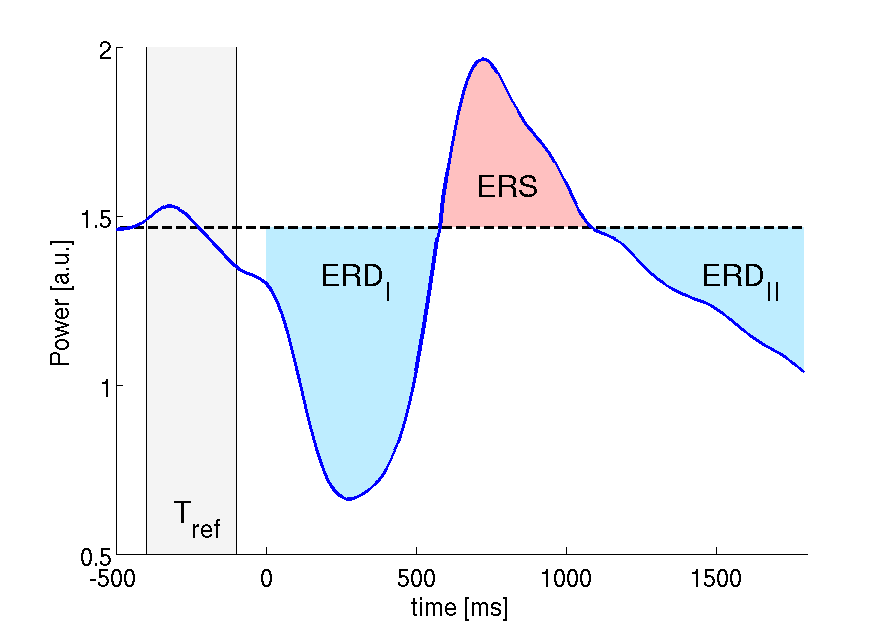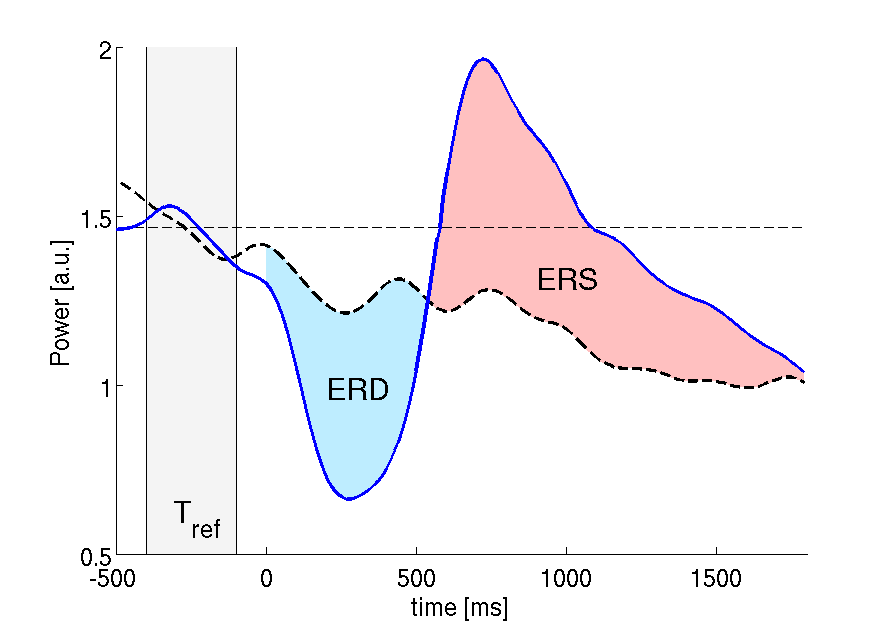- Basics
- Publication (PDF)
- Software
- Example
- Imprint
This is the companion website to the publication A Generalized Framework for Quantifying the Dynamics of EEG Event-Related Desynchronization (ERD), that introduces a generalized measure for ERD. Moreover, the approach encompasses also the more general notion of a state conditional ERD through which candidate explanatory variables can be scrutinized with regard to their possible impact on a particular oscillatory dynamics under study. The example of somatosensory induced ERD outlines the potential of the state conditional ERD framework by means of the analysis of the conditional dependency of mu-rhythm ERD on the state of the local prestimulus mu-rhythm activity.
When Hans Berger described the human EEG in the 1920s, a pivotal finding was the demonstration of prominent oscillations in the frequency range between 8 and 12Hz, which he called alpha wave rhythm. He also described for the first time the so-called alpha blockade, i.e., the suppression of the ongoing alpha activity when the subject opens his eyes. In the 1970s Gert Pfurtscheller and colleagues introduced the term event-related desynchronization (ERD) for this kind of frequency specific changes of ongoing EEG activity.


Conventional ERD measures the relative deviation of the event-related dynamics (solid) from a constant baseline level (dashed). The baseline is typically estimated as averaged power across a reference interval prior the event (grey shaded region).
The standard measure of ERD quantifies the
induced change in signal band power as difference between a baseline
prior to the event an an post-event period. By convention an ERD
corresponds to a negative value, i.e., a decrease in power, while
event-related synchronization (ERS) refers to an increased signal
power. Note, changes of signal power are quantified only with respect
to the deviation from a fixed, constant baseline level.


Generalized ERD: measures the relative deviation of the event-related dynamics (solid) from a dynamic baseline (dashed). The dynamic reference is estimated from catch trials, i.e., as averaged power across trials without processing the event under study.
We generalize the conventional ERD framework with
respect to the choice of reference. In particular, we substitute the
constant baseline by a reference dynamics and derive a
generalized measure by defining ERD/S as the relative deviation of the
event-related dynamics from this reference dynamics. Specifically, we
propose the use of the natural relaxation dynamics of the unperturbed
EEG rhythm as reference, which can be obtained from catch
trials.
The main advantage of the generalized ERD (gERD) measure is due to its ability to reliably study ERD responses even in the presence of dynamical cortical states, i.e., for the analysis of non-stationary dynamics. However, the generalized and the conventional measure of ERD yield identical results when analyzing stationary dynamics and the superiority of gERD becomes evident only in case of non-stationary dynamics. One particular application field of gERD is the investigation of state conditional dependencies of ERD dynamics, i.e., investigation of explanatory factor of inter-trial variability. Here the conditional event-related as well as the reference dynamics are not necessarily stationary. The example of somatosensory induced ERD reveal the basic principles and differences of the two approaches.
Moreover, we provide Matlab code that enables the reader to reproduce the state conditional ERD analysis of surrogate ERD data given in the manuscript, but can also be used as a basis for the analysis of state condition ERD in general.
Copyright © 2009 S. Lemm, K.-R. Müller, and G. Curio.
The original work was published under the Open Access License, which allows anyone to download, reuse, reprint, modify, distribute, and/or copy articles in PLoS journals, so long as the original authors and source are cited. If the item you plan to reuse is not part of a published article (e.g. a featured issue image), then please indicate the originator of the work, and the volume, issue and date of the journal in which the item appeared.For any reuse or redistribution of a work, you must also make clear the license terms under which the work was published.